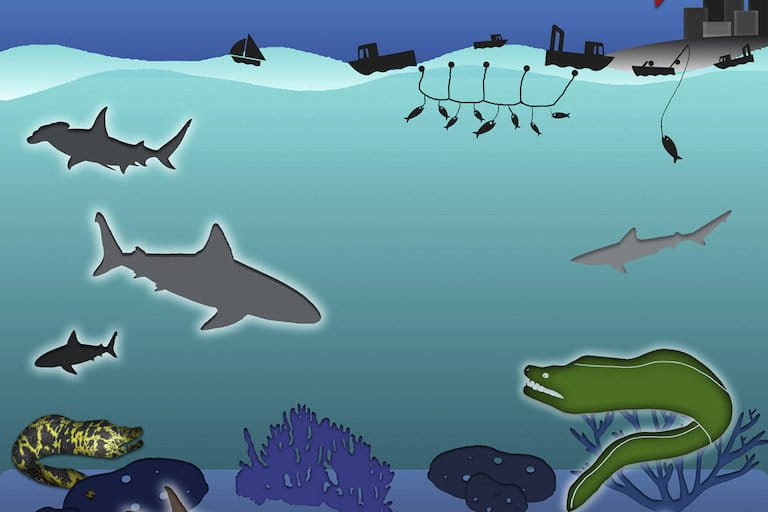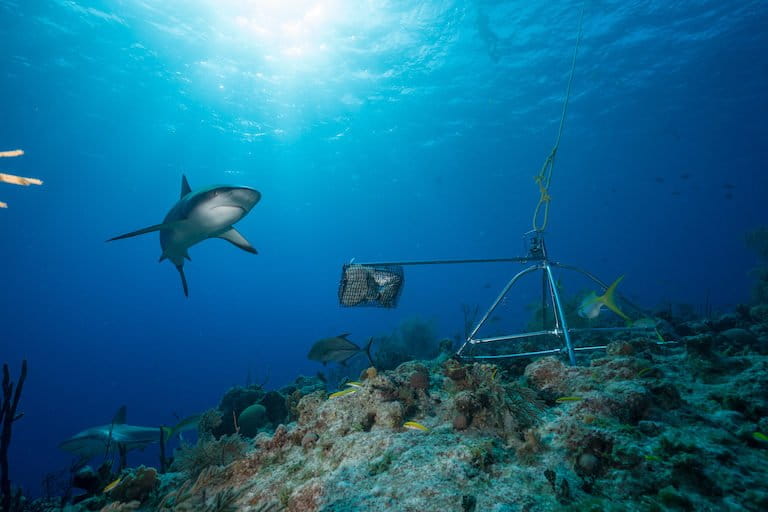When Demian Chapman and his colleague first started setting up underwater cameras on reefs in 2015, the aim was to capture a lot of shark video. But sometimes they got moray eels instead. Particularly at reefs where sharks were no longer present.
“It was feast or famine,” Chapman, associate professor in the department of biological sciences at Florida International University (FIU), told Mongabay in an interview. “On reefs with sharks, you would see no eels. On reefs without sharks, that’s when you started seeing eels.”
After collecting years of anecdotal evidence, Chapman and a team of international researchers embarked on a study: they wanted to see if data would back up their assumptions that eels were indeed present on shark-free reefs. The resulting paper, which was recently published in iScience, found that nearby markets had a negative impact on sharks and other reef fish in the Caribbean region, but didn’t have the same effect on moray eels. Consequently, eels were more abundant in places where sharks weren’t.

In the paper, this phenomenon is referred to as “market gravity.” The closer a reef is to a city, the fewer fish that reef will have. This is due in part to people fishing and harvesting species from nearby reefs, but also because non-target species have to travel further away to find their own food sources when nearby reefs become depleted.
“When you look at the sharks, they follow the same pattern as all other reef fish — you tend to find them further away from humans,” Chapman said. “Moray eels are the exact opposite, which in and of itself is surprising. So they’re doing very well despite this law of gravity.”
One explanation could be the simple fact that moray eels don’t taste very good and contain high levels of toxins, so they’re not regularly fished by people, Chapman says. But this doesn’t explain everything.
The hypothesis mentioned in the paper is that “the positive effect of market gravity on morays could be an indirect result of a local reduction in moray predators, competitors, or both on reefs subject to higher human pressure.”

“It’s likely that [moray eels] compete with sharks for prey so it could be possible that if you have less sharks, there’s less competition for the moray so they have access to more prey,” lead author Gina Clementi, a researcher at FIU, told Mongabay in an interview. “Or it could be [that] there’s less sharks to prey upon them.”
But there’s still a lot unknown about the dynamics between moray sharks and eels, she said.
“This opened up a can of worms,” Clementi said. “We found that we don’t really know much about moray eels ecology so [it would be good to see] deeper studies into that function and that role they play on a coral reef system.”
The research team obtained their data by setting up underwater video systems (BRUVS) — baited with oily sardines or herring — on 67 reefs in 12 Caribbean countries. This was conducted as part of the Global Fin Print project, a research initiative that assesses coral reef sharks and rays through underwater survey work. They also took eDNA — genetic material from environmental samples — to assess when and where moray eels are present.

Samantha Sherman, a post-doctoral research fellow at Simon Fraser University in British Columbia, Canada, who was not involved in this study but has worked on the Global Fin Print project, said she found similar results when examining the relationships between sharks and rays. In a paper published in May 2020, Sherman and her colleagues found that reefs with fewer sharks tended to have more rays, and that rays were also more likely to visit BRUVS when sharks weren’t nearby.
“In our study … we found that the presence of sharks at a reef significantly affected if the rays were present, how many times rays circled and visited the BRUVS, how long they spent at the bait, and if they fed,” Sherman told Mongabay in an email. “This shows sharks can affect many aspects of their prey species lives, which will have impacts on the entire ecosystem.”
Joshua Reece, a moray eel expert and biologist at California State University, Fresno, who was also not involved in this study, said the findings corroborate his own observations, although he never undertook an empirical study on the subject.
“I sampled moray eels within the Hawaiian archipelago for my dissertation work,” Reece told Mongabay in an email. “I could regularly catch 100 moray eels a night using lobster traps in heavily overfished and impacted nearshore waters of the inhabited Hawaiian islands, and I would catch barely a dozen with the same sampling effort in the uninhabited and relatively pristine northwestern Hawaiian islands. The main thing you notice when you jump in the water is that sharks are uncommonly seen in the inhabited Hawaiian islands, while any dive in the uninhabited northwestern Hawaiian islands might result in several dozens or hundreds of sightings.

“I think [the study] was well executed and a great contribution to our understanding of moray eels and more broadly, the myriad, cascading, and often unanticipated impacts that humans can have when we muck with ecosystems,” he added. “To quote the great Frank Egler, ‘Nature is not just more complicated than we think, it is more complicated than we can think.’”
So what happens when a reef is full of moray eels, but sparse on sharks? This question needs to be probed with further research, but Chapman says he thinks it could change the behavior of reef fish.
“[Moray eels] hunt quite differently from a lot of the other reef predators in that they are using the bottom to creep up and ambush their prey from below, whereas a lot of the other reef fish are going to be expecting attacks from above and from the sides,” he said. “So I could envision a lot of changes if the dominant predator is moray eels.
“It’s very, very early days,” he added, “but what this study tells us is that we really need to pay attention to these moray eels and figure out what they do. Because apparently, we create situations that are better for them, and that could have some knock-on effects on the reef ecosystem that could certainly affect fish, crustaceans, octopuses, and maybe even algae and coral.”

Moray eels might be having their day in the sun, but the family of species could face its fair share of challenges in the future as climate change flattens their reef habitats and people become more interested in eating them, says Chapman. In Indonesia, there are already fisheries targeting moray eels.
“I would definitely say that for right now they’re doing okay by people,” Chapman said. “But with climate change, and maybe target fishing, and maybe overfishing of their prey, we might end up with a situation where even they succumb [from] being close to humans.”
Citation:
Clementi, G. M., Bakker, J., Flowers, K. I., Postaire, B. D., Babcock, E. A., Bond, M. E., … Chapman, D. D. (2021). Moray eels are more common on coral reefs subject to higher human pressure in the greater Caribbean. iScience, 102097. doi:10.1016/j.isci.2021.102097
Sherman, C., Heupel, M., Moore, S., Chin, A., & Simpfendorfer, C. (2020). When sharks are away, rays will play: Effects of top predator removal in coral reef ecosystems. Marine Ecology Progress Series, 641, 145-157. doi:10.3354/meps13307
Source: Mongabay


















